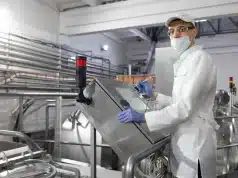The modern world is evolving exponentially faster every day. New technologies are being created, sold, and then made obsolete sometimes within less than a year. Some of this is due to rampant consumerism (looking at you, Apple), but some of this is because the technology really is improving that quickly (looking at you, EasyBet Casino). The Oculus 2 launched last October, and already Mark Zuckerberg has mentioned in interviews that FaceBook and the Oculus team are already working on the Oculus 3, 4, and beyond.
Eh, well, that’s probably another example of out-of-control capitalistic greed, but I swear that there is new, amazing technology out there! One field of such technology is the medical industry. We’ve been living through a pandemic, and the fact that we managed to endure, survive, and defeat a virus in just over a year, with far fewer deaths than estimated, is an unprecedented victory for humanity.
But that’s not even half of it. Here are some new amazing new technologies and medical advances that will make you think that we’re living in a world of science-fiction!
Fixing Spinal Damage with Asparagus
Nope, the headline wasn’t clickbait. A lab really did manage to fix spinal damage using a vegetable and is pushing to get human trials underway.
Andrew Pelling’s labwork is all about studying how to use fruits and vegetables in a bizarre and unique way. Basically, he can strip a plant, like an apple, of all its internal DNA and cellular components. This process leaves behind just the natural plant fibers- the stuff that creates the physical structure of the plant. The round apple shape, for instance.
Once these internal bits and bobs are removed, it’s possible to inject living tissue into the structure, which will use the plant-like scaffolding and grow in whatever shape it’s guided into. Andrew Pelling and his team managed to extract all the internal components of an apple, carved it into the shape of an ear, and regrew an ear this way.
They were also able to surgically attach the ear, and the body recognized this new ear, and blood vessels grew back to connect to it. That way, the body started pumping blood to it. This is important because one of the main dangers of surgery is rejection. If the body doesn’t recognize an organ, like a transplanted kidney, it will try to expel it. This is why not just anyone can trade body parts and blood with anyone else, and they usually have to be taken from someone with similar enough DNA, like a sibling or a parent.
So, according to Andrew Pelling, he was preparing dinner one night, and after he chopped the ends off an Asparagus, he noticed that the stalks had “micro-channel vascular bundles”. This is an extremely nerdy way to say that the asparagus is full of little tubes. It then occurred to him that this was similar to a whole division of bio-engineering effort aimed at treating spinal injuries.
Now, he rightfully acknowledges that plant cells don’t exactly belong in the human body. Ideally, a good treatment would leave only natural tissue fibers, but plant fibers don’t break down in the human body. The body doesn’t produce the right enzymes to do it. However, this is why it works so well in the first place because the body doesn’t even seem to notice it. This is super useful because regrowing cells can still take advantage of the “scaffolding” without other internal systems trying to eject said scaffolding.
To make a long story short(er), Pelling and his team surgically severed the spines of rats, which paralyzed their back legs. They then used these Asparagus channels to repair it. Ideally, the nerves would eventually grow back and, guided by the scaffolding, reconnect the two severed ends of the spine. Lo and behold, months afterward, the rats with surgical implants began to show signs of regaining use of their legs.
This is a breakthrough. Pelling and his team didn’t use pharmaceuticals, electrostimulation, stem cells, or even physical therapy. These rats started healing naturally, helped only by a (relatively) simple implant. Don’t take my word for it either. The FDA has labeled this technology as a “breakthrough medical device”, which fast tracks it through a bunch of red tapes. This means that human trials could happen as early as two years from now (which, might I add, is a very short time frame to go from Animal to Human trials).
If you’re interested in the whole story, I highly recommend Andrew Pelling’s Ted talk on YouTube.
Virtual Reality: The Next Major Medium
Civilization was fundamentally changed when writing was invented several thousand years ago. Books became more accessible with the invention of the printing press in 1440 AD. A new art form was created with the invention of film in the late 1800s. The first interactive medium came about in 1958 when the first video game, “Tennis for Two,” was put on display.
Well, we’ve advanced a lot in all of those mediums, and not one had lost their relevancy, despite what some naysayers might say. People are reading more books than ever. Movies are bigger than they ever have been, both in their production and at the box office. Video games, meanwhile, have become their own art form capable of anything from crude violence to beautiful storytelling.
But that’s not the end of it. Virtual Reality is here, and while it has yet to become mainstream yet, we could be less than a decade or two away from having VR as widely available as the smartphone.
At the moment, at least, it remains hampered as an expensive hobby. The technology is too bulky. The headsets cost too much. The games are scarce. The ones that are available (with only a handful of exceptions) are cobbled together junk that more likely to make you nauseous than amazed. That being said, more recent titles like Half-Life: Alyx are steadily changing that.
Still, that’s no reason to throw out the baby with the bathwater. Both of these problems are being worked at furiously by a multitude of companies, including Oculus, Valve, HTC, and Microsoft. The latter of whom just signed a deal with the US Spaceforce to work on a VR Helmet that can be used to train astronauts to fix satellites.
There are also plenty of companies working on peripherals to improve the VR experience. Haptic Gloves, for instance, are being tackled by several companies and range in quality from simple “buzzing” like a controller to ones that lock your hand and simulate touch and texture when you hold virtual objects.
Then there are more out-of-the-box peripherals, like the Decamove, which adds a way to track your movement from your hips. This opens a whole range of motion that just wasn’t possible with a headset alone and is compatible out of the box with just about any VR game on the market.
Virtual Reality is getting better, cheaper, and more convenient with each new model. There are probably aspects of VR I can’t even think of that are going to become radically different by the end of the 2020s. Soon enough, I’m sure the current industry headsets are going to go the way of the Blackberry and flip-phones.
But I particularly love the idea of using VR to train and learn in a safe, controlled environment. This isn’t practical for every kind of field. A mechanic could just walk outside to his car, for instance. However, putting on a VR helmet to learn how to fix satellites is a lot cheaper than going to space to practice, right?
But there’s even something for the rest of us plebs too. There are actually college courses you can take right now using VR, and because it’s in VR, it’s probably the coolest schooling experience you’ll ever have. I saw a demonstration that took the students on a tour of the human body. With VR, every class becomes an episode of The Magic School Bus, and that’s awesome!
The Future is Now!
So what do you think is the coolest new technology? I think there’s a whole wave of new technology on the horizon that’s going to revolutionize how we live our daily lives. From glasses-sized VR headsets to asparagus-based medical technology to rocket taxies taking us from New York to Tokyo in an hour, I truly think the world is becoming bigger and better than it ever has been. No matter what Twitter says about the matter.
I think, coming out of one of the hardest years many of us have ever had to endure in our lives, there’s a lot we have to be proud of. It may not feel like it, but I think a majority of that pessimism and negativity comes from media (both Social and Mainstream) constantly pushing the worst of us onto pedestals because it generates traffic.
But we endured. We’re just about to take down a vaccine that ground the planet to a halt. There’s so much more that we’re successfully taking on, and life, science, and technology are going to get better from here. There’s a light at the end of the tunnel, and we’re running full-sprint towards it.
Let’s just hope that we’re not joyfully running at an oncoming train, eh?





